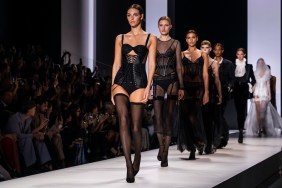tFS: So why did you want to make that a core component of your label and brand? When it might have been easier to just follow the standard industry practices?
JP: Because I wanted to do something that I knew was the right thing to do. And also, it’s almost like being an investigative journalist or reporter, I wanted to find out for myself. It was a very personal mission, initially. And then the more that I learned about it, the more I wanted to share it with the universe. And then … it happened. I’ve been very fortunate that I’ve had a lot of opportunities to share and tell my story and help tell the bigger story and help other people. We did a book, years ago, with Earth Pledge — Diane Von Furstenberg wrote the introduction — it was called the Fashion White Pages. It’s not so well-known anymore because it went out of print. But at the time, it was Julie Gilhart, myself and a host of other people who were early adaptors. We knew that the material supply chain was in need of a change. I don’t know if anybody understood the full scope of how damaged it all was.

I wrote a speech this spring that was read at Fordham Law. There’s no title to the speech, but it was read ten days before disaster happened in Bangladesh and I was talking about the last disaster that happened in Bangladesh, in November 2012. And I was basically warning the industry that if they didn’t pay attention to this kind of stuff, that something of a larger magnitude and scale was going to happen. To my saddest regret, it happened ten days later. These are the kinds of things that I’m constantly thinking about and working on and being aware of personally. And sometimes at a great emotional expense. It’s hard because we’re not a philanthropy — as people remind me.
The climate conference that just happened in Warsaw is interesting because it’s parallel to the conversation our industry is having…sometimes people just don’t want to hear it. Inexpensive clothing can be wonderful but it also can be very damaging to the people who make it. I think that’s the hard aspect of it, because we all need clothing. We need utilitarian clothing and we also need clothing for beauty, to make people happy. Even in the simplest way, in indigenous communities, they use clothing as a language — you know, the language of embroidery, the language of pattern. Maintaining a lot of these traditions — that’s something we’re at a critical juncture with now. Because a lot of that is being lost due to big box stores opening all over the world, making it much easier for people just to run and buy some little inexpensive thing just to cover themselves. There’s not the reverence for the heritage as much anymore.
It’s interesting because the young people, they’re going to be the ones to carry the movement to the next level. By developing their own brands and supporting things that they believe in. Because I think with the younger generation…they don’t buy into the old school stuff. They don’t know what it was like in the 80s or the 90s — even like the 2000s. That might as well be 2,000 years ago, to them! Now people are like, “Oooo, VFiles. Oh yeah, all this new stuff…” And I’m pretty turned on by that. We look at everything here. We’re cognizant of what’s going on in the world, to a point. But when one of my programmers here said to me before, they were like, “Let’s just like pay attention to it for like 20 minutes a day and the rest of the time, let it ride.” And I thought, “Yeah, that’s healthy.”







